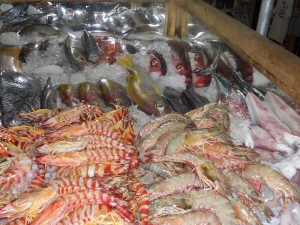Seafood Sustainability
Recipe Key
 Summer is a great time to enjoy fish but how do you know which fish are healthy and good for the environment.
Summer is a great time to enjoy fish but how do you know which fish are healthy and good for the environment.
Eating fish is a great source of lean protein with Omega 3’s and great health benefits. Unfortunately some fish can be bad for you and bad for our environment. Seafood can be contaminated with high amounts of mercury which are toxic and can build up in your system.
Mercury is a naturally occurring element that is produced by industrial pollution. It falls from the air into bodies of water, and is then absorbed by fish. High levels of mercury can harm the brain, heart, kidneys, lungs and immune system. All fish contain trace amounts of mercury. The levels depend on what the fish eat, how long they live, how big they are and how high they are in the food chain. Larger fish that have lived longer tend to have higher levels of mercury.
Some varieties of fish have been depleted causing lasting damage to our oceans and marine life. We need our oceans to be healthy. The oceans supply us with food, help regulate our climate, and supply a livelihood for millions of people. Just as important, we depend on the oceans for recreation and renewal. But our seas are not the infinite bounty they appear to be.
When buying fish either at the store or in a restaurant follow these basic principles to make choices that are good for your health and the health of our oceans.
* Eat lower on the food chain
Smaller fish tend to be more plentiful and better for your health because they contain less mercury. Great small seafood choices include squid, oysters, mackerel, sardines and mussels. As a general rule the smaller the fish the lower it is on the food chain. Avoid swordfish, bluefin tuna, farmed salmon, grouper, monkfish and tile fish.
* Buy wild
Given current issues with the environmental impact of fish farming, a wild-caught fish is almost always better than a farmed fish of the same variety for your health and the environment.
* Eat local
You’re usually better off eating the local variety of a particular type of fish instead of its counterpart from across the country or another part of the world, unless that species has been depleted in local waters. Fresh fish must be transported by air, the most energy-intensive method of shipping.
* Know how its caught
Hook and line is a low-impact method of fishing that does no damage to the seafloor and lets fishermen throw back unwanted species, usually in time for them to survive. Intelligently designed traps are also good since they have doors that allow young fish to escape
* Know where fish is from
The health of different species varies by region. Use the Monterey Bay Aquarium’s Seafood Watch guide to learn which regions provide the most sustainable seafood choices.
*Source as much Marine Stewardship Council certified sustainable seafood as possible
The Marine Stewardship Council certifies seafood that is caught or raised in a sustainable, environmentally friendly manner. Items that meet its criteria are marked with a MSC-certified label.
Whole Foods Market also certifies their farmed fish with “Responsibly Farmed” standards. Their standards prohibit use of antibiotics, added growth hormones, added preservatives like sulfites and phosphates, genetically-modified seafood, and land animal by-products in feed.
*Organic fish does not mean anything
In the United States there are no standards for organic agriculture so the label is meaningless until the government set up national organic standards for farm raised seafood
*Canned fish suggestions
The best canned fish is Wild Salmon or Sardines packed in olive oil. Check to see there are no preservatives or additional ingredients. If you must have canned tuna the type recommended by the MB Seafood Watch is white albacore which are troll or pole caught from the US.

2 Comments